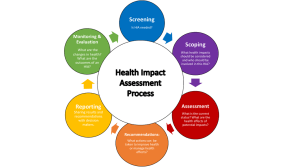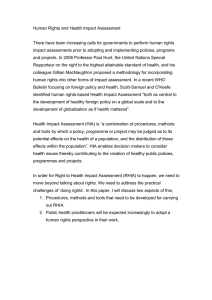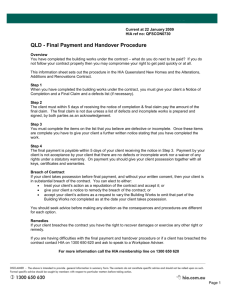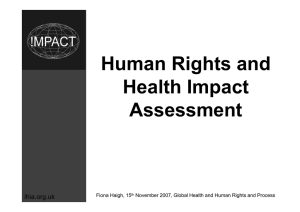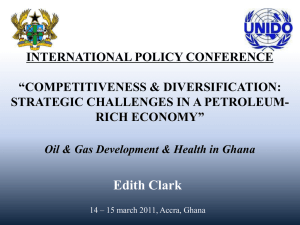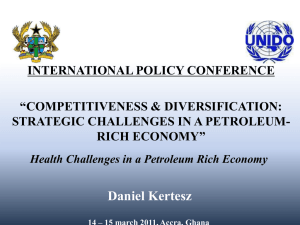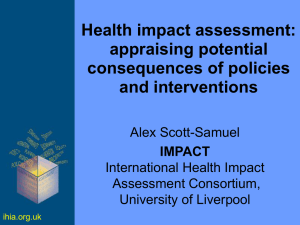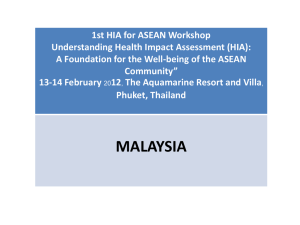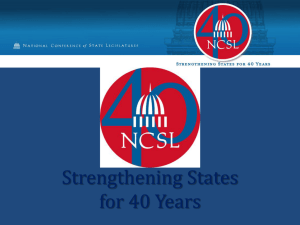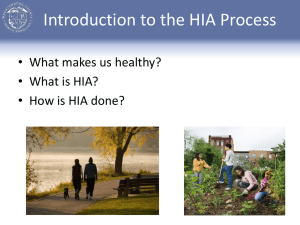Participatory evaluation of the health, environmental and
advertisement
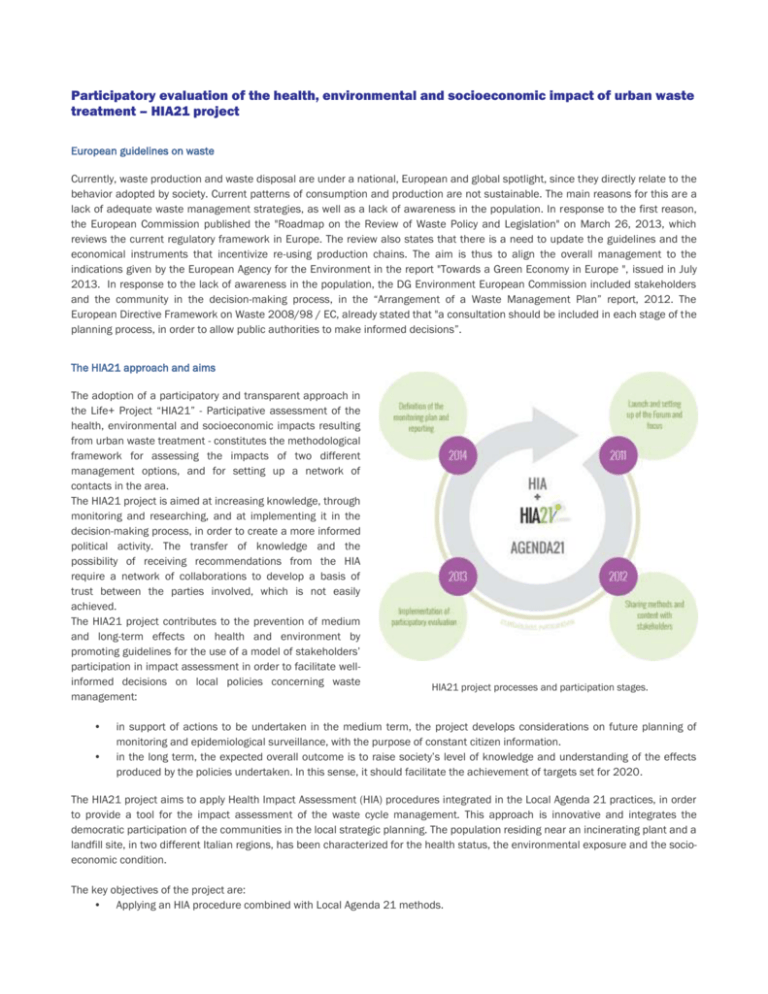
Participatory evaluation of the health, environmental and socioeconomic impact of urban waste treatment – HIA21 project European guidelines on waste Currently, waste production and waste disposal are under a national, European and global spotlight, since they directly relate to the behavior adopted by society. Current patterns of consumption and production are not sustainable. The main reasons for this are a lack of adequate waste management strategies, as well as a lack of awareness in the population. In response to the first reason, the European Commission published the "Roadmap on the Review of Waste Policy and Legislation" on March 26, 2013, which reviews the current regulatory framework in Europe. The review also states that there is a need to update the guidelines and the economical instruments that incentivize re-using production chains. The aim is thus to align the overall management to the indications given by the European Agency for the Environment in the report "Towards a Green Economy in Europe ", issued in July 2013. In response to the lack of awareness in the population, the DG Environment European Commission included stakeholders and the community in the decision-making process, in the “Arrangement of a Waste Management Plan” report, 2012. The European Directive Framework on Waste 2008/98 / EC, already stated that "a consultation should be included in each stage of the planning process, in order to allow public authorities to make informed decisions”. The HIA21 approach and aims The adoption of a participatory and transparent approach in the Life+ Project “HIA21” - Participative assessment of the health, environmental and socioeconomic impacts resulting from urban waste treatment - constitutes the methodological framework for assessing the impacts of two different management options, and for setting up a network of contacts in the area. The HIA21 project is aimed at increasing knowledge, through monitoring and researching, and at implementing it in the decision-making process, in order to create a more informed political activity. The transfer of knowledge and the possibility of receiving recommendations from the HIA require a network of collaborations to develop a basis of trust between the parties involved, which is not easily achieved. The HIA21 project contributes to the prevention of medium and long-term effects on health and environment by promoting guidelines for the use of a model of stakeholders’ participation in impact assessment in order to facilitate wellinformed decisions on local policies concerning waste management: • • HIA21 project processes and participation stages. in support of actions to be undertaken in the medium term, the project develops considerations on future planning of monitoring and epidemiological surveillance, with the purpose of constant citizen information. in the long term, the expected overall outcome is to raise society’s level of knowledge and understanding of the effects produced by the policies undertaken. In this sense, it should facilitate the achievement of targets set for 2020. The HIA21 project aims to apply Health Impact Assessment (HIA) procedures integrated in the Local Agenda 21 practices, in order to provide a tool for the impact assessment of the waste cycle management. This approach is innovative and integrates the democratic participation of the communities in the local strategic planning. The population residing near an incinerating plant and a landfill site, in two different Italian regions, has been characterized for the health status, the environmental exposure and the socioeconomic condition. The key objectives of the project are: • Applying an HIA procedure combined with Local Agenda 21 methods. • • • • • Involving locals in a process to establish guidelines for urban waste management in the area, experimenting methods of participation which include public forum meetings and the active work of focus groups. Evaluating the health, environmental and socioeconomic impact of the incinerator and landfill, through means approved by the scientific community. Deepening awareness of local communities concerning their role in land-management policies. Developing guidelines to support local planning policies. Developing an international network between public bodies and research institutions. The model of participation within the HIA case studies When defining the community’s participatory model in the HIA21 project, an adaptation of the Local Agenda 21 practice to the project needs and goals was required. A model composed by three main subjects with different roles was identified. Besides the project leading group a forum and a focus group were created. The roles of each subject were defined as below described. The HIA21 leading group of researchers and HIA21 project local partners, provides the evidence on impacts and the terms of reference of the process. The forum, constituted by individuals from the community, aims at sharing processes, results and final recommendations. The focus groups of local experts work on targeted themes. They integrate the content of the work done by the forum and the HIA21 leading group, evaluating processes and results. Moreover, in the final phase participate to the definition of the monitoring plan. The overall goal of the participative process is to integrate the local knowledge within the impact assessment of the current local waste cycle management. Two waste treatment plants in Italy were selected for case studies development: the municipal solid waste landfill located in Lanciano (CH) and the municipal solid waste incinerator in Arezzo. An HIA was applied retrospectively to both plants, with the support of Agenda21L participatory processes, above described. The five stages of HIA were applied during the project: Screening and Scoping of impacts (phases 1 and 2), which were analysed with local stakeholders. Impact assessment (Assessment - Phase 3), whose findings were presented to decision-makers and citizens. Recommendations and Reports (Reporting - Phase 4) developed during meetings with stakeholders. Monitoring (Monitoring - Phase 5) activities were designed during 4 focus group sessions with the stakeholders to assess the trend of selected indicators and evaluate the implementation of the recommendations over time. Transferring knowledge to the decisions: the condition of success The Lanciano case study suffered from a political background and an administrative component with a low awareness about the potential to promote local health and environmental quality by a sustainable waste management system. This was an obstacle to collect and provide the best available information to the impact assessment and monitoring phase. However the project emphasized the relevance of the local policies and actors in the reduction of waste production and the improvement of recycling. Moreover, the large consultation of the communities by questionnaire provided a picture on the socio economic status and their feeling about the current waste policy in the area. The perception of health status and waste management service proved to be strongly influenced by age, level of education and income. An Agenda 21 forum on the specific issue of waste was established. The Arezzo case study demonstrated that the HIA21 participative model was effective in supporting the decision about the new interprovincial waste plan. The HIA21 project increased interest in waste issues in the general population and generated collective expectations concerning the decisions of the new waste management plan, and the identification of optimal management alternatives. Some public events focusing on the issues of waste cycle were developed in collaboration with the Municipality. Local administration and policy makers became key players in the achievement of project objectives. The assessment of the environmental, health and socio-economic impacts was conducted through a process of involvement of local stakeholders up to the drafting of recommendations and monitoring indicators. The contribution of citizens and stakeholders during the project modified the decision of local administrators of doubling the incinerator's capacity in favor of differentiated waste collection, which passed from the target 65% to 70%. Conclusion The network of collaborations, that was built involving the community and the municipality administrators, was fundamental to collect new data and share the project results. Findings of the health and socioeconomic studies supported the selection of sustainable waste cycle management in Arezzo, and also, pushed the plant owner to provide deeper analysis of impacts from different waste management scenarios. The HIA21 approach facilitated the building of trust among relevant parties – citizens, administrators, owners, local actors - and the conduction of the assessment of impacts. Also, it increased the sensibility and awareness within the community. The setting up of a systematic channel for communicating and informing citizens is desirable to improve the knowledge of the area by local decision makers in order to plan targeted interventions in areas with environmental pressures that would improve social equity.
